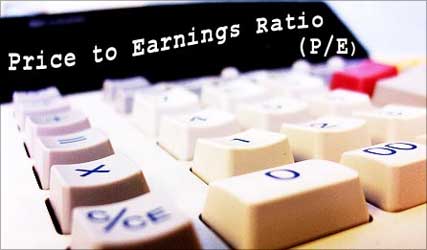
Commonly called the PE ratio (or just PE), it is often used in investment analysis. However, investors sometimes fail to understand the factors that determine it and its limitations
What is it?
The PE ratio is calculated by dividing a company's share price by its earnings per share (EPS).
So, if we assume that a company's share price is Rs 200 and its EPS is Rs 10, the PE of the stock will be 20 (Rs 200 divided by Rs 10).
Note that the EPS of a company can be calculated in different ways, resulting in more than one PE for the same stock.
If the EPS for the last 12 months (four quarters) is used, the resulting PE is called trailing-twelve-month (TTM) PE.
If the EPS for the next twelve months is forecasted and used in calculation, the resulting PE is called forward PE.
For a company that operates in a cyclical industry, the EPS considered is the average EPS over the complete cycle, and it is called seasonally adjusted PE.
Click on NEXT to read more...

Interpreting the ratio
As the calculation of the ratio suggests, the PE multiple implies the amount an investor is paying for each rupee of the company's EPS.
So, if the PE of a stock is, say, 20, the investors are paying Rs 20 for each rupee of the company's EPS.
The higher the PE ratio of a stock, the more investors are paying for that stock, and vice-versa.
That explains why it is said that a high or a low PE implies whether the stock is expensive or cheap, respectively.
Click on NEXT to read more...

How much should you pay?
The PE of a stock should ideally depend on some factors. The first is growth. Growth is directly proportional to PE.
The higher the growth, the higher will be the PE that the stock should command.
The second factor is risk, and it is inversely related to PE. So, a stock should have a low PE if the risk associated with it is high.
A company's dividend policy also determines its PE.
The greater the proportion of profit given as dividends, the higher will be the PE.
As shares do not always trade at a price based on their fundamentals, a stock's existing PE could differ from the one that should be based on the factors determining it.
So, pay for a stock based on these determinants.
Click on NEXT to read more...

The limitations
With various accounting standards available, a company's EPS figure will depend on which method it follows.
In other words, the PE ratio gets influenced by the accounting norms.
Also, when a company's earnings are negative, assigning a value to its stock using PE is not feasible.